Accepted Scientific Name: Discocactus zehntneri Britton & Rose
Cactaceae (Britton & Rose) 3: 218. 1922 [12 Oct 1922] Britton & Rose
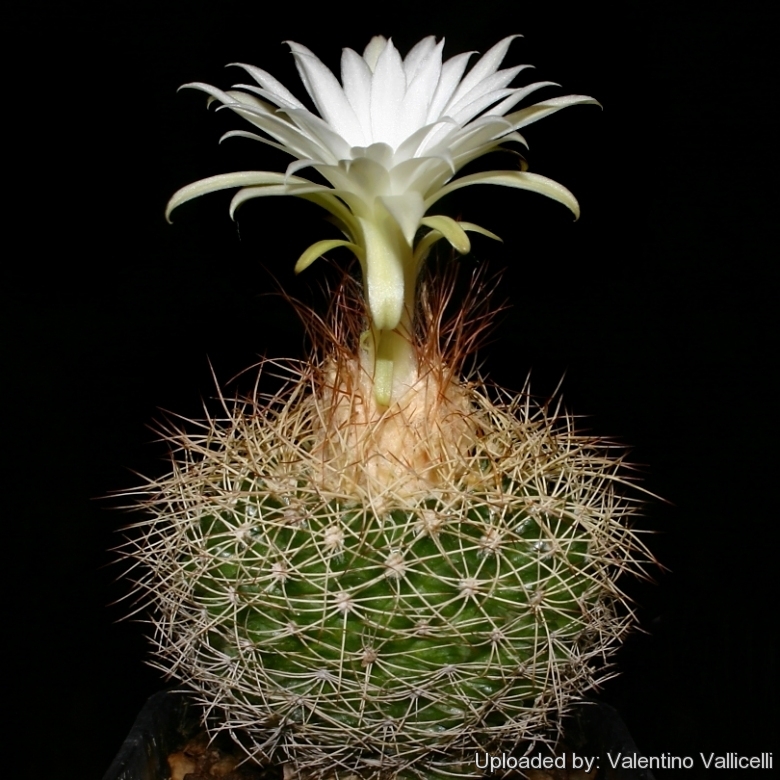
Discocactus zehntneri subs. horstiorum Photo by: Valentino Vallicelli
Origin and Habitat: West of Morro do Chapéu, Bahia, Southern Brazil. Discocactus zehntneriSN|12925]]SN|12925]] v. horstiorum represent the northern populations of Discocactus zehntneriSN|12925]]SN|12925]] subs. boomianus, but this two form cannot be satisfactorily separated and probably are the same.
Altitude range: Around 700–1000 metres above sea level.
Habitat and ecology: This species grows on exposed arenitic rocks or ‘pedra canga’ (iron- and manganese rich conglomerate rock), often with an accumulation of gravel, or in pure quartz sand.
Synonyms:
See all synonyms of Discocactus zehntneri
Description: Discocactus zehntneri v. horstiorum is a squat tiny little cactus with dark tipped yellowish spines, the flowers are up to 9 cm long. It has tuberous roots. Although having been described as a distinct taxon, it cannot be satisfactorily separated from Discocactus zehntneriSN|12925]]SN|12925]] subs. boomianus based on morphology. In culture it produces just like boomianus many offsets.
Stem: Strongly caespitose, dull-green 4.2 –9.7 in diameter and 1.5 – 6.4 cm tall (often larger in cultivation especially if grafted).
Ribs: 13 – 26 (mostly 16), somewhat spiraled, forming nipple-like tubercles, height of rib at the areole 3 -13 mm, between areoles absent or rarely to 7 mm tall, width of rib at the areole 7-16 mm, between areoles 3-12 nn.
Areoles: Oval, sunken, 2-7 (mostly 5) per ribs.
Radial spines: Interlacing, densely covering the plant, 11 to 21 (mostly 14). 1.3-4.4 (mostly 2.5 cm) cm long, 0.4 mm in diameter, pectinate, flexible spines creamy white or whitish-yellow with dark tips, becoming pale-brown to whitish, recurved backwards, sitting on the plant like spiders.
Central spines: None or rarely 1 to 3.6 cm in length and 0.8 mm in diameter. Cephalium: 6 to 50 mm tall, 13 to 5.4 cm in diameter, at the apex of the plant, creamy-withe to light-brown with yellow to brownish bristles. Bristles on the periphery of the cephalium 1.4 -9.0 in length.
Flowers: White, scented, slender funnelform, up to 9 cm long. The position of the stigma is at the top of the stamens. Each flowering lasts only one night, but that night it produces many flowers.
Fruits: Club-shaped red 2,5 cm long. The plant produces seed-pods twice a year, when it flowers.
Remarks: This plant is part of the Discocactus zehentneri complex which comprises several variable subordinates taxa, but not all are universally recognized.
Subspecies, varieties, forms and cultivars of plants belonging to the Discocactus zehntneri group
 Discocactus zehntneri Britton & Rose: Usually globose and completely covered in white thin, needle-like spines, the flower is about 3 cm long and the fruit are red (Origin: Sentocé)
Discocactus zehntneri Britton & Rose: Usually globose and completely covered in white thin, needle-like spines, the flower is about 3 cm long and the fruit are red (Origin: Sentocé) Discocactus zehntneri subs. albispinus (Buining & Bredero) P.J.Braun & Esteves: has larger flattend stems. Spines fewer, longer, white and more recurved. Distribution: South-east of Sento Sé in the Serra do San Francisco, Bahia.
Discocactus zehntneri subs. albispinus (Buining & Bredero) P.J.Braun & Esteves: has larger flattend stems. Spines fewer, longer, white and more recurved. Distribution: South-east of Sento Sé in the Serra do San Francisco, Bahia. Discocactus zehntneri subs. araneispinus (Buining & Bredero) P.J.Braun & Esteves: It has 10 to15 flexible, interlacing spines up to 1-2 cm long, that are pectinate, flexible, creamy white or whitish-yellow with dark tips, becoming pale-brown to whitish, recurved backwards, sitting on the plant like spiders.
Discocactus zehntneri subs. araneispinus (Buining & Bredero) P.J.Braun & Esteves: It has 10 to15 flexible, interlacing spines up to 1-2 cm long, that are pectinate, flexible, creamy white or whitish-yellow with dark tips, becoming pale-brown to whitish, recurved backwards, sitting on the plant like spiders. Discocactus zehntneri subs. boomianus (Buining & Bredero) N.P.Taylor & Zappi: Usually disk -shaped, with dark tipped yellowish spines, the flowers are up to 9 cm long. It has tuberous roots. (Origin: Morro do Chapéu municipality, Chapada Diamantina, Bahia)
Discocactus zehntneri subs. boomianus (Buining & Bredero) N.P.Taylor & Zappi: Usually disk -shaped, with dark tipped yellowish spines, the flowers are up to 9 cm long. It has tuberous roots. (Origin: Morro do Chapéu municipality, Chapada Diamantina, Bahia) Discocactus zehntneri subs. buenekeri (W.R.Abraham) P.J.Braun & Esteves: This species does share the complex commonality of tuberculate ribs and basal offsetting, but its white, club-shaped fruit does not fit with the dark red , much elongated and slender fruit of the other taxa.
Discocactus zehntneri subs. buenekeri (W.R.Abraham) P.J.Braun & Esteves: This species does share the complex commonality of tuberculate ribs and basal offsetting, but its white, club-shaped fruit does not fit with the dark red , much elongated and slender fruit of the other taxa. Discocactus zehntneri subs. horstiorum (P.J.Braun) P.J.Braun & Esteves: Slow growing form (Origin: near Minas do Mimosa, Moreno, Sierra do Espinahaco, Bahia )
Discocactus zehntneri subs. horstiorum (P.J.Braun) P.J.Braun & Esteves: Slow growing form (Origin: near Minas do Mimosa, Moreno, Sierra do Espinahaco, Bahia )
Bibliography: Major references and further lectures
6) Edward Anderson “The Cactus family” Timber Press, Incorporated, 2001
7) James Cullen, Sabina G. Knees, H. Suzanne Cubey "The European Garden Flora Flowering Plants: A Manual for the Identification of Plants Cultivated in Europe, Both Out-of-Doors and Under Glass" Cambridge University Press, 11/Aug/2011
8) David R Hunt; Nigel P Taylor; Graham Charles; International Cactaceae Systematics Group. "The New Cactus Lexicon" dh books, 2006
9) MARLON CÂMARA MACHADO “O gênero Discocactus Pfeiff. (Cactaceae) no estado da Bahia, Brasil: variabilidade morfológica, variabilidade genética, taxonomia e conservação” Dissertação apresentada ao Programa de Pós-Graduação em Botânica da Universidade Estadual de Feira de Santana como parte dos requisitos para a obtenção do título de Mestre em Botânica. Universidade Estatual de Feira de Santana – Bahia 2004 pages 91-92
10) BRAUN, P.J. 1990. “D. zehntneri var. horstiorum P.J.Braun.” Kakteen und andere Sukkulenten 69: 218.
 Discocactus zehntneri subs. horstiorum Photo by: Valentino Vallicelli
Discocactus zehntneri subs. horstiorum Photo by: Valentino Vallicelli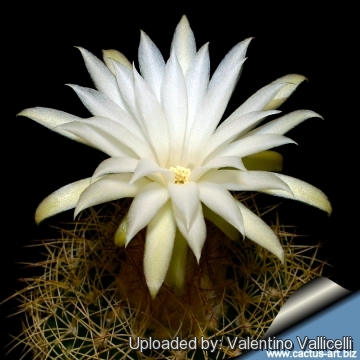 Discocactus zehntneri subs. horstiorum Photo by: Valentino Vallicelli
Discocactus zehntneri subs. horstiorum Photo by: Valentino Vallicelli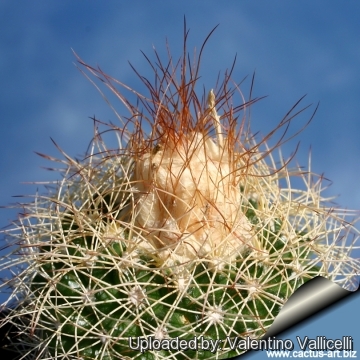 11.00 A.M. No sign of flowering at all... Photo by: Valentino Vallicelli
11.00 A.M. No sign of flowering at all... Photo by: Valentino Vallicelli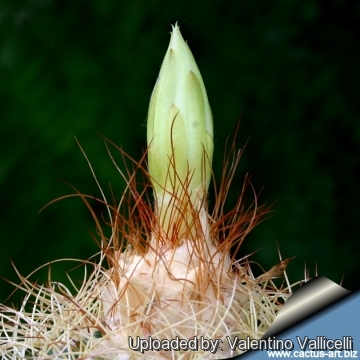 6.00 P.M. ... a bud is growing up ... Photo by: Valentino Vallicelli
6.00 P.M. ... a bud is growing up ... Photo by: Valentino Vallicelli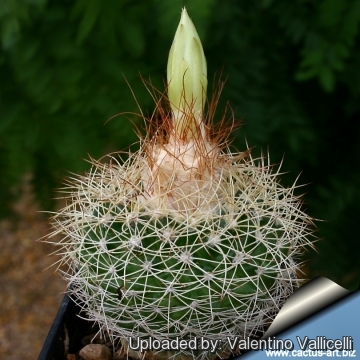 7.00 P.M. ... it is almost ready to open ... Photo by: Valentino Vallicelli
7.00 P.M. ... it is almost ready to open ... Photo by: Valentino Vallicelli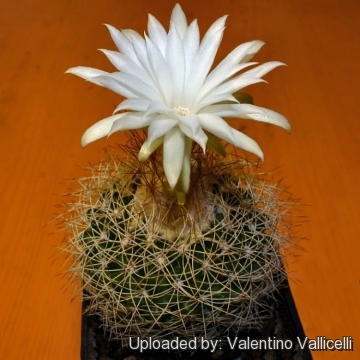 8.00 P.M. ... the flower at full anthesis!!! Photo by: Valentino Vallicelli
8.00 P.M. ... the flower at full anthesis!!! Photo by: Valentino Vallicelli At Rebutialand cactus collection Demjén, Hungary. Photo by: Agócs György
At Rebutialand cactus collection Demjén, Hungary. Photo by: Agócs György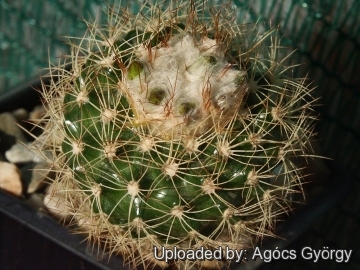 At Rebutialand cactus collection Demjén, Hungary. Photo by: Agócs György
At Rebutialand cactus collection Demjén, Hungary. Photo by: Agócs GyörgyCultivation and Propagation: It is one of the easiest species of the genus to grow, but even so it isn't a plants for beginners, in fact collectors consider the Discocactus to be rarities with requires skilful cultivation. It is rather difficult to grow and frost tender, it can’t stand cold, or even fairly cool temperatures and should be kept at above 15° C if grown on its own roots (8°C if grafted). Need full sun or afternoon shade. They are slow growing and very rot prone when kept on their own roots and though they can’t endure long stretches of total dryness, too much water will rot them, as their weak root systems tend to be inefficient at sucking up water from wet soil. They generally resent being repotted and can take a long time to establish. When grown to maturity, however, it possess an exotic look shared by no other cacti, and it generally attract a lot of attention.
Propagation: Seed or cuttings. Young seedlings are generally grafted on a low stock to keep the plant in a good shape.



















